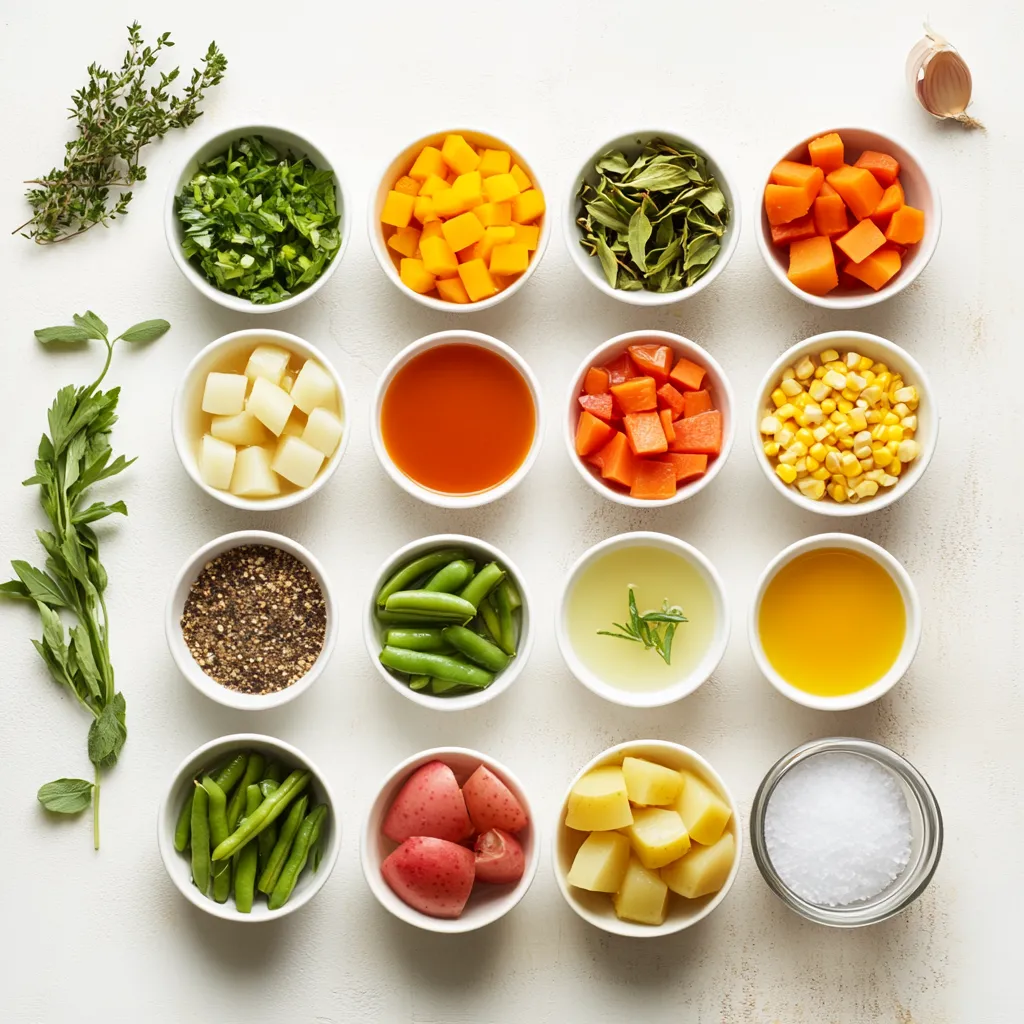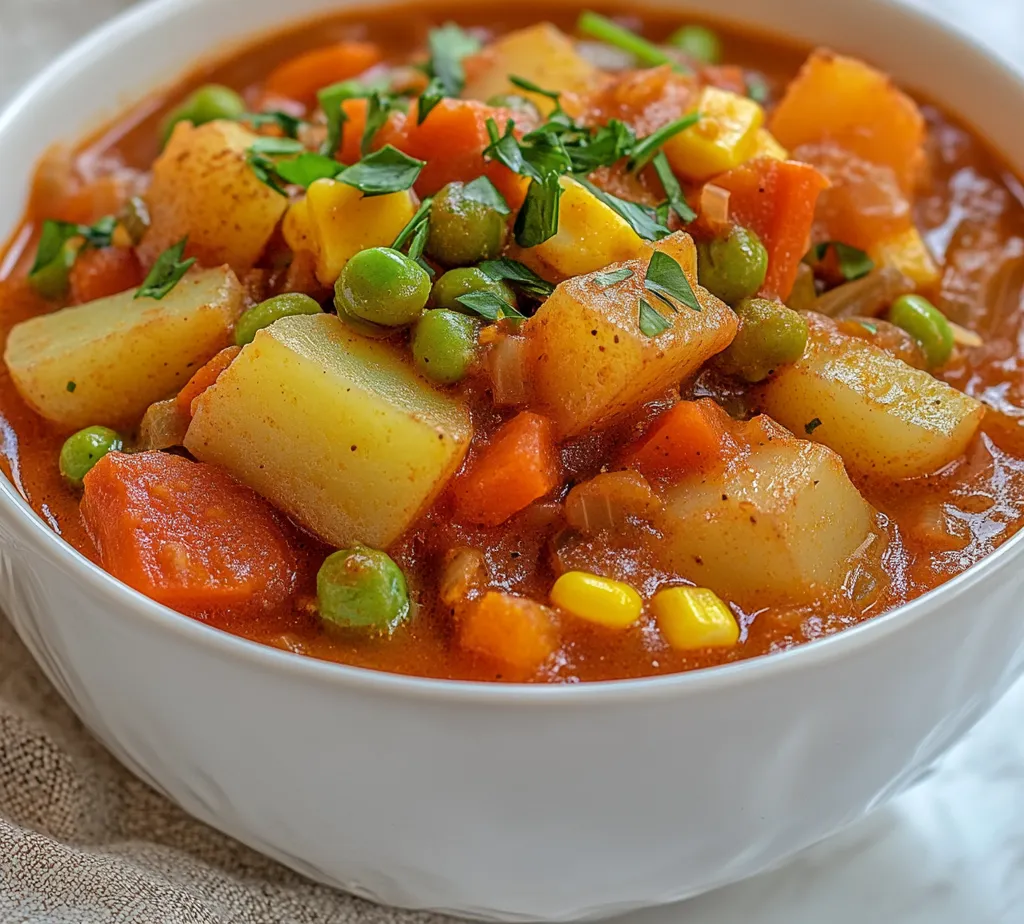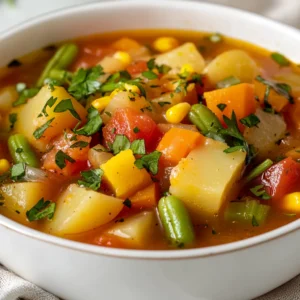Introduction
Exploring the rich flavors of autumn through a wholesome vegetable medley stew is a delightful experience for any home cook. This hearty recipe not only celebrates seasonal produce but also provides a nutritious and comforting meal option that can suit any palate. With vibrant colors and a medley of textures, this stew offers not just sustenance but also a warm hug in a bowl, perfect for those chilly evenings when cozying up at home is a priority. Whether you are cooking for family or friends, this dish serves as a centerpiece that brings everyone together and warms the heart.
The wholesome autumn vegetable medley stew promises a perfect balance of flavors. Each ingredient shines, creating a layered taste experience that reflects the best of what fall has to offer. The sweet tenderness of butternut squash marries beautifully with hearty potatoes and vibrant green beans, while aromatic herbs elevate the dish to a new level of comfort and reassurance. This recipe is particularly suited for gatherings, potlucks, or simply when you want a satisfying dish that requires minimal fuss.
Not only is this stew easy to prepare, but it also caters to a variety of dietary preferences, making it a versatile choice. The use of simple, fresh ingredients ensures that this stew is wholesome and filling, without being complicated to make.
Recipe Overview
– Cooking Method: Slow-cooking in a crockpot
– Difficulty Level: Easy
– Preparation and Cooking Time: Total of 6-8 hours with 15 minutes of prep
– Servings: Ideal for 6-8 portions
Ingredients
A comprehensive list of necessary ingredients to create this delicious stew:
– 4 cups vegetable broth
– 2 cups diced potatoes (your choice of variety)
– 1 cup chopped carrots
– 1 cup chopped celery
– 1 cup diced butternut squash
– 1 can (15 oz) diced tomatoes (with juice)
– 1 cup green beans, trimmed and cut into 1-inch pieces
– 1 cup corn (fresh or frozen)
– 1 medium onion, diced
– 3 cloves garlic, minced
– 1 teaspoon dried thyme
– 1 teaspoon dried basil
– 1 bay leaf
– Salt and pepper to taste
– 2 tablespoons olive oil
– Fresh parsley for garnish (optional)

Instructions
1. Prepare the Vegetables: Begin by thoroughly washing all vegetables. Chop them into uniform, bite-sized pieces to promote even cooking and enhance the overall texture of the stew.
2. Sauté the Aromatics: Heat olive oil in a skillet over medium heat. Once the oil shimmers, add the diced onion and minced garlic. Sauté for about 3-5 minutes until the onion turns translucent and releases a fragrant aroma.
3. Combine Ingredients in the Crockpot: Transfer the sautéed onion and garlic mixture into a crockpot. Add the diced potatoes, chopped carrots, celery, butternut squash, green beans, corn, and the can of diced tomatoes (including the juice).
4. Incorporate Broth and Seasonings: Pour in the vegetable broth, ensuring all ingredients are well mixed. Sprinkle in the dried thyme, dried basil, bay leaf, and season with salt and pepper to taste. Make sure the vegetables are fully submerged in the broth for optimal flavor.
5. Cook the Stew: Cover the crockpot with its lid. Set the temperature to low and let it cook for 6-8 hours or on high for 3-4 hours, until the vegetables are tender and the flavors meld beautifully.
6. Finishing Touches: After cooking, carefully remove the bay leaf. Taste the stew and adjust the seasoning as needed to enhance the flavors.
7. Serve and Enjoy: Ladle the hearty stew into bowls. For an added touch, garnish with freshly chopped parsley if desired. This wholesome stew pairs wonderfully with crusty bread or can be served over a bed of rice for a satisfying meal.
Preparing the Vegetables
Proper vegetable preparation is crucial for enhancing both flavor and texture in the stew. Fresh, high-quality vegetables not only contribute to the taste but also improve the nutritional value of the dish.
Washing and Cleaning
Thorough washing of vegetables cannot be overstated. It’s essential to rinse each component under cold water to remove dirt and any pesticides. For root vegetables, like potatoes and carrots, using a vegetable brush will provide a more thorough clean. After washing, lay them on a towel to dry before chopping, to avoid excess moisture that might dilute the stew.
Chopping Techniques
Chopping vegetables into uniform pieces ensures that they cook evenly. For this stew, aim for bite-sized pieces, roughly the same size, as this will help them cook at the same rate. Using a sharp knife will facilitate easier chopping and lead to cleaner cuts. Always cut away from your body to avoid accidents, and keep your fingers tucked in to protect them.
Importance of Fresh Ingredients
Using fresh versus frozen produce can significantly change the overall flavor profile of your dish. Fresh vegetables contain more natural sugars and juices, enhancing the stew’s richness. However, if you’re pressed for time, frozen vegetables are a convenient alternative, often frozen at peak freshness, which can be a great way to enjoy seasonal flavors all year round.
Sautéing the Aromatics
Sautéing aromatics, such as onion and garlic, lays the flavor foundation for the entire stew. This technique infuses the dish with aromatic notes and enhances the final flavor profile.
Heating the Oil
The temperature of the oil is critical when sautéing. Heating olive oil just until it shimmers indicates that it’s ready for the aromatics. If the oil gets too hot and begins to smoke, it can lead to bitterness in the final dish. Keeping the heat at medium ensures a controlled environment for sautéing.
Adding Onion and Garlic
Onions and garlic are considered the backbone of countless dishes. When added to the heated oil, they begin to sweat, releasing their natural flavors into the oil. Sautéing the onion until translucent (but not browned) enhances the sweetness of the onions and the aromatic quality of the garlic, creating an inviting base.
Perfecting the Sauté
Achieving just the right translucency is essential. Monitor the onions closely, stirring occasionally to ensure even cooking. Once they reach that perfect stage of translucency, the fragrant garlic should follow, added just a minute or two before transferring to the crockpot, to avoid burning and ensure its flavor remains vibrant.
Combining Stew Ingredients
Integrating all components into the crockpot is a straightforward yet significant step that sets the stage for perfecting your stew.
Transferring Aromatics
Once the onion and garlic are perfectly sautéed, carefully transfer them to the crockpot. This process ensures that all the deliciously infused oil and flavor comes along, adding depth to your stew.
Adding Vegetables
Layering different vegetables in the crockpot is key. Begin with the heartier vegetables like potatoes, which need longer cooking times, followed by faster cooking varieties such as green beans. This order promotes even cooking, ensuring that no vegetable is overcooked while waiting for others to catch up.
Incorporating Tomatoes
Using canned tomatoes in your stew not only adds acidity and depth but also a touch of sweetness. Ensure to add the entire can, juice and all. The liquid will help deglaze the pan’s remnants while cooking, providing additional flavor to your stew. The tomatoes help distribute moisture to the other ingredients, promoting a consistent stew consistency and flavor throughout.
This wholesome autumn vegetable medley stew is a comforting dish, rich in seasonal flavors and nourishing ingredients, making it an excellent choice for any time of year, especially as the temperatures start to drop.

Seasoning the Stew
Understanding the seasoning process and its impact on flavor is crucial to creating a delicious vegetable medley stew. The layering of flavors from various seasonings dramatically enhances the overall profile of the dish.
Mixing in Broth
When adding vegetable broth to the stew, aim to fully cover the array of vegetables. Proper mixing ensures that every ingredient is well combined with the broth and flavored evenly. To achieve this, gently stir the mixture after adding the broth, ensuring that the solid ingredients are submerged and preventing any sticking or burning at the bottom. This step is essential for melding the various tastes, as well as achieving a harmonious flavor throughout the stew.
Adding Dried Herbs
Dried herbs such as thyme and basil are not merely for garnish; they play a significant role in contributing to the taste of the stew. Thyme lends an earthy note and complements the sweetness of the butternut squash and corn, while basil adds a hint of freshness that balances the rich undertones of the tomatoes. The infusion of these herbs increases as the stew simmers, so it’s important to let them bloom in the hot broth, which helps release their essential oils and ensures robust flavor.
Balancing Flavors
Achieving balance in seasoning is key to taste perfection. Salt and pepper are fundamental in enhancing the other flavors present in the stew. Start with a mild dash of salt—tasting as you go—and adjust accordingly, keeping in mind that the flavors will deepen and develop further during the cooking process. Remember, a little goes a long way, and over-salting can easily overshadow the natural sweetness of the vegetables.
Cooking the Stew
Insights into the actual cooking process provide guidance for achieving the best results with your vegetable stew.
Choosing Cooking Settings
The choice between low and high cooking settings can affect the final product. Cooking on low heat (for 6-8 hours) allows the flavors to meld together more fully—a slow infusion that creates a deeper flavor profile. Conversely, using the high setting (for 3-4 hours) is a quicker method and is ideal if you’re short on time. However, the flavors may not develop as richly as they do during low cooking.
Timeline and Monitoring
Monitoring the cooking progress is vital for ensuring optimal doneness. If using the low setting, check the stew around the 6-hour mark while maintaining patience, as jumping the gun might mean the vegetables are not tender enough. For high heat, the 3-hour mark can serve as an initial check. Look for a bubbling broth, which indicates that the cooking process is well underway and that the ingredients are tender.
Understanding Vegetable Doneness
Understanding when vegetables have reached the right texture is crucial. Potatoes should be tender when pierced with a fork, while carrots and squash should retain some firmness but not be crunchy. Overcooked vegetables might start to break down, leading to a mushy stew. Aim for a balance of soft, yet distinct pieces of each vegetable to achieve that coveted hearty texture.
Final Touches
The finishing steps to perfecting your stew can elevate it from good to great.
Removing the Bay Leaf
Before serving the stew, ensure to carefully remove the bay leaf—the flavors are imparted throughout the cooking, but the leaf itself is inedible and can impart a bitter taste if left in. This attention to detail not only enhances the flavor but also shows care in presentation.
Adjusting Seasoning
As you approach the final stages of preparation, tasting the stew is a must. Adjust seasoning as necessary, potentially adding a pinch more salt or a dash of black pepper. This final adjustment lets you tailor the stew to your preferences and ensure a delightful dining experience for all.
Presentation Ideas
Serving the stew in rustic bowls can enhance its comforting appeal. Consider drizzling a little extra olive oil on the top or using fresh herbs as a vibrant garnish. Additionally, you might create visual interest by placing chunks of crusty bread on the side for dipping or providing a sprinkle of chili flakes to cater to varying spice tolerances.
Serving Suggestions
Complementary items can greatly enhance the overall dining experience.
Rustic Bowls
Choosing the right serving dish, such as earthenware bowls, can evoke a sense of warmth and rustic comfort that complements the hearty stew. Deep bowls are ideal for holding generous portions and for scooping up the accompanying bread.
Accompaniments
Aside from bread, consider serving the stew over a bed of rice or quinoa for added nutrition and a delightful base that absorbs some of the broth’s flavors. A side salad featuring fresh greens can add a refreshing contrast to the warm, rich stew.
Extra Garnishes
Enhancing the stew with extra garnishes can elevate its flavor profile. A touch of chili flakes can give a hint of spice, while a drizzle of good quality olive oil just before serving brings richness and elevates the dish’s presentation.
Nutritional Benefits
Exploring the health advantages of the stew’s ingredients underscores its wholesome nature.
Vegetable Nutrition
This stew is packed with a variety of vegetables rich in vitamins and minerals. Potatoes offer potassium, while butternut squash provides an abundance of beta-carotene, necessary for eye health. Carrots contribute vitamin A, and the range of greens offers fiber, all valuable components for a balanced diet.
Benefits of Plant-Based Meals
This stew is an excellent option for vegan and vegetarian diets, providing all necessary nutrients without animal products. The abundance of vegetables ensures a meal high in antioxidants and fiber, supporting overall health and well-being.
Importance of Whole Foods
Utilizing whole foods, as present in this stew, allows for optimal health benefits. Whole ingredients free from preservatives and additives contribute to a greater nutritional profile and promote better digestion, making it ideal for regular consumption.
Flavor Profile
Describing the overall taste and texture experience of the stew adds depth to your understanding.
Depth of Flavor
The slow cooking process significantly enhances the flavor components, melding them into a cohesive broth that elicits comforting imagery of home-cooked meals. Each ingredient contributes uniquely, making every spoonful a rich, satisfying experience.
Textural Contrast
The interplay between the tender vegetables and the slightly crunchy green beans or fresh corn adds an appealing textural contrast. This mix ensures that the stew is not only hearty but also interesting to eat.
Aroma
As the stew simmers, it creates enticing scents that waft throughout the kitchen, melding aromas of roasted garlic, hearty broth, and fragrant herbs. This sensory experience amplifies anticipation for the meal and invites those nearby to gather around the table.
Conclusion
The wholesome autumn vegetable medley stew beautifully showcases the flavors and textures of seasonal ingredients. With its comforting broth and variety of tender vegetables, this meal provides both nourishment and satisfaction. Though preparation requires patience, the resulting stew is a robust and delightful addition to any autumn gathering.

Wholesome Autumn Vegetable Medley Stew Recipe
Ingredients
- 4 cups vegetable broth
- 2 cups diced potatoes
- 1 cup chopped carrots
- 1 cup chopped celery
- 1 cup diced butternut squash
- 1 can diced tomatoes with juice
- 1 cup green beans trimmed and cut into 1-inch pieces
- 1 cup corn
- 1 medium onion diced
- 3 cloves garlic minced
- 1 teaspoon dried thyme
- 1 teaspoon dried basil
- 1 leaf bay leaf
- to taste salt and pepper
- 2 tablespoons olive oil
- for garnish fresh parsley optional
Instructions
- Wash and chop all vegetables into uniform pieces.
- Heat olive oil in a skillet over medium heat and sauté diced onion and minced garlic until translucent.
- Transfer the sautéed mixture to a crockpot.
- Add diced potatoes, chopped carrots, celery, butternut squash, green beans, corn, and diced tomatoes to the crockpot.
- Pour in vegetable broth and mix well, adding thyme, basil, bay leaf, salt, and pepper.
- Cover and cook on low for 6-8 hours or high for 3-4 hours until vegetables are tender.
- Remove the bay leaf and adjust seasoning if needed.
- Serve in bowls, garnished with parsley if desired.

